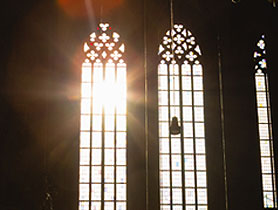May 19, 2014
Living with Darkness
 This past week I was in a bad mood for what seemed like a long time. Maybe it was stress. Maybe there was a relationship I needed to fix. Maybe my life was a bit overbooked and I needed to slow down. I couldn’t quite figure out what it was, so I just tried to go about my days.
This past week I was in a bad mood for what seemed like a long time. Maybe it was stress. Maybe there was a relationship I needed to fix. Maybe my life was a bit overbooked and I needed to slow down. I couldn’t quite figure out what it was, so I just tried to go about my days.
Pretending like nothing was wrong didn’t help (and my wife saw right through that). It didn’t go away until I paid attention to my bad mood and explored it a bit and realized I just needed a little time alone (I’m very introverted and get grouchy when I’m around people for too long without a break) and a little more sleep. It was a minor lesson, for sure, and looking back on it, pretty obvious, but I could not learn it until I paid attention to my bad mood.
Recently I read Barbara Brown Taylor’s new book, Learning to Walk in the Dark. It’s a lovely book, exploring metaphorical and literal darkness. It rejects the “full solar spirituality” that doesn’t allow for shadow, and instead embraces a lunar faith, that waxes and wanes, that doesn’t pretend everything is always sunny.
“Dark and light,” she writes, “faith and doubt, divine absence and presence, do not exist at opposite poles. . . . As different as they are, they come from and return to the same source.”
I think we all know that life isn’t always sunny, that there are dark spots. Constantly fighting these dark moments and moods off is so much work, and sometimes denies us the opportunity to learn about ourselves and to grow. Of course, not all darkness is good, but there are times that we should allow our darkness in and pay attention to it, because it can teach us.
This is a lesson for us as individuals, but also as communities. We should not deny the difficulties of community, the doubts and fears and negative emotions that arise. We do church in the dark on the Easter Vigil, literally, and we should take some time to look into our metaphorical dark places as well, so we can live better together, more honestly and openly.
This includes paying attention to friction in the church and being honest about uncertainties in our future. This might mean classes that address fear or embrace doubt and an attitude from leadership that does not fear or ignore conflict and pain in the community, but instead views them as opportunities for growth and ministry.
There is nothing wrong with us when we experience doubt and conflict and darkness. There is no light without shadow, at least not in this life. Pretending that everything should be sunny at all times will only make us feel like there is something wrong with us when our lives together aren’t always smooth.
Are you looking into the dark places in your community?





